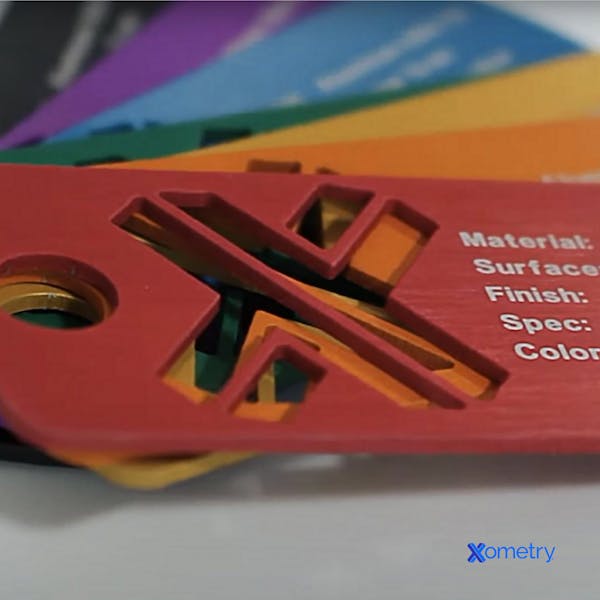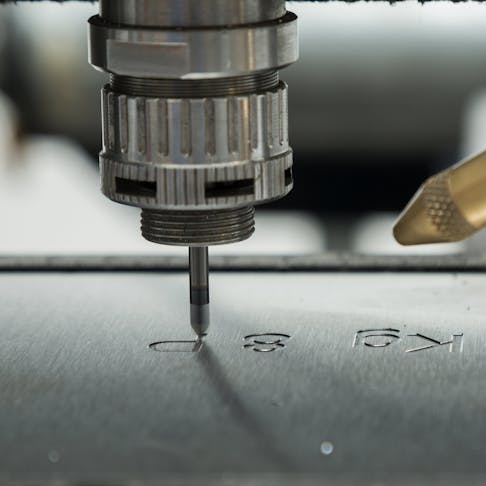Engraving is the method of carving a design onto a hard, usually flat surface by cutting grooves into it with a burin. The result may be a decorated object, as when silver, gold, steel, or glass are engraved, or it may be a printing plate, for printing images on paper as prints or illustrations. These printed images are also called "engravings." Engraving is one of the oldest and most essential techniques in printmaking.
The first evidence for human engraving patterns dates back between 540,000 and 430,000 years in Indonesia. Hand engraving on bone and ivory was an important art technique during the upper paleolithic era, and larger engraved petroglyphs on rocks were found from many prehistoric periods and cultures worldwide. Some examples of modern uses for engraving include creating text on jewelry or pet tags or adding a winner's name on trophy plates. Engraving is also used in the printing industry with engraved metal plates.
Engraving Marking
Marking is actually a different process than engraving, as is etching. Although these names are often used interchangeably, there are differences between marking, etching, and engraving. Each process has its own attributes that make it ideal for different applications.
Laser marking uses a beam that interacts with a material's surface, slightly altering its properties and appearance. A low-powered beam moves slowly across the material, causing discoloration and creating high-contrast marks without disturbing the workpiece. The laser heats it, causing oxidation under the surface, and applies low temperatures to the metal to anneal the surface. This leaves the surface intact. Marking is less commonly used than etching or engraving.
Types of Engraving
There are five main types of engraving, that we'll dive into below.
Hand Engraving
Hand engraving is one of the most intricate and labor-intensive engraving methods. It is typically done using a small engraving tool by a master artist. Hand engraving is a long and expensive process, but the results produced are unique works of art that are nearly impossible to replicate.
The oldest form of hand engraving is called “push engraving.” The artist uses sharp engraving tools and pushes it into the substance hard enough to leave a mark. This type of engraving is taxing on the human hand, so it can’t be done for prolonged periods of time.
This technique is also limited to certain materials as it can be challenging to etch into hard surfaces using push engraving.
Laser Engraving
Laser engraving is when the laser beam physically removes the workpiece’s surface to create a cavity that reveals an image at eye level. The laser produces high heat during the engraving process, which essentially causes the substance to vaporize.
Laser engravers produce lettering, logos, or designs into a variety of materials such as wood, acrylic, stone, leather, and coated metals. For example, acrylic awards, wooden picture frames, pet urns, rifle stocks, marble coasters, cutting boards, iPad covers, portfolios, and name badges are often engraved using the laser process. It can be divided into deep laser engraving and laser ablation. It is not ideal for marking safety-critical parts. It is the fastest method of marking items, is cost-effective, and is ideal for parts that will experience high wear.
Become an Expert in All things Sheet Metal Fab
CNC Engraving
Computed numerically controlled, or CNC, engraving is an increasingly popular industrial engraving that uses CNC machines to control engraving using a computer. This computerized engraving machine has a spindle and drive system manipulated by a computer to engrave, or cut, the desired material in a specified pattern along three axes of a plane. It works using input data from a user and fabricates the engraving very quickly. This process is beneficial on an industrial level because it allows items such as dog tags or plaques to be massively delivered at a high rate. It is also helpful for industrial purposes because it reduces manual labor.
Rotary Engraving
Rotary engraving uses a spinning cutter with a motor-powered spindle to cut or "rout", either entirely through the substrate to create cut-out shapes or at a programmed depth to create grooves that form characters and graphics. The rotary machine engraving method can be used to engrave a wide range of materials, including various plastics, acrylic, glass, wood, ceramic, stone, and solid surface.
Diamond Drag Engraving
Diamond engraving is a variation of rotary engraving. The same machine can be used with a diamond-tipped, non-rotating cutter called a "graver" to mark different materials by scribing lines or grooves into the surface. This method is used mainly for engraving metal.
Using a diamond drag engraver, Rotary engraving systems can also engrave on just about any machinable bare metal such as aluminum, brass, stainless steel, silver, gold, platinum, and titanium. This means the rotary process can be used to personalize just about any item, including off-the-shelf items. Some applications of rotary engraving include watches and jewelry, identification bracelets, pens, die struck medals, charms, and brass or aluminum plates.

Exploring Engraving Machines
A mechanical engraving machine uses a model or stencil to transmit a design onto the workpiece. The cutter on the machine then marks the material with the desired design or description. Mechanical engravers have traditionally been a big part of the printing process.
A laser engraver is a more modern development since the development of laser technology. Unlike mechanical machines, a laser marks the material in a laser engraver instead of a cutting tool. A computer is typically necessary to operate a laser engraver because the new technology tends to be more complicated. The software that runs a laser engraving machine may come packaged with the machine or available for separate purchase.
Most jewelry engravers are a subset of laser engravers. These machines are designed to handle the delicate work of engraving jewelry. Laser machines are more detailed than older engraving machines. The precise laser can handle both flat and curved surfaces. Engraving machines have also gotten smaller, so they can now fit into small shops or kiosks where customers may ask for personalized engraving on jewelry, photo frames, and other keepsakes.
Summary
More information about the other types of part marking technologies may be found by exploring our Ultimate Guide to Direct Part Marking. That guide covers the different part marking techniques and contains additional information on the types of markings we perform and what we'll do in case of missing information to ensure your order gets to you on time while remaining fully compliant with your specifications.
Disclaimer
The content appearing on this webpage is for informational purposes only. Xometry makes no representation or warranty of any kind, be it expressed or implied, as to the accuracy, completeness, or validity of the information. Any performance parameters, geometric tolerances, specific design features, quality and types of materials, or processes should not be inferred to represent what will be delivered by third-party suppliers or manufacturers through Xometry’s network. Buyers seeking quotes for parts are responsible for defining the specific requirements for those parts. Please refer to our terms and conditions for more information.
Sources:


